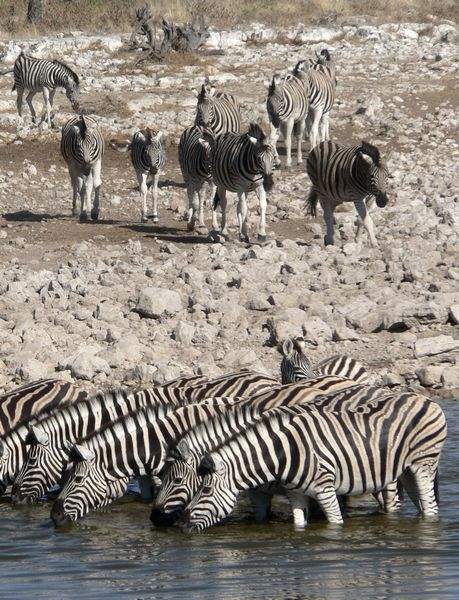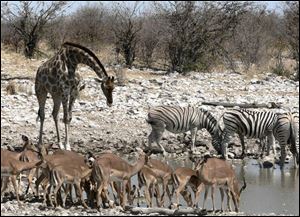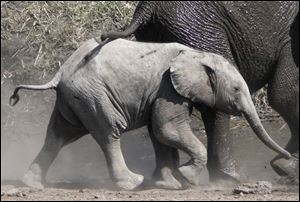
Sand dunes, wildlife await visitors in spectacular Namibia
1/20/2008
Zebras in Namibia's Etosha National Park.
Ute von Ludwiger / ASSOCIATED PRESS

Zebras in Namibia's Etosha National Park.
ETOSHA, Namibia - Two prides of lions stretched luxuriously in the midday sun, casting an occasional lazy glance at crowds of zebras, impalas, and giraffes waiting anxiously for a turn to quench their thirst at the water hole.
Nearby, plume-puffing ostriches stood in the shadow of mud-caked elephants in the shimmering afternoon heat punctuated only by whirlwinds of dust. In the distance, herds of wildebeest and gemsbok emerged on the vast salt plain.
Typical scenes on an average day in Namibia's Etosha National Park, which is home to rare black rhinos and the world's largest population of cheetahs and where a single photo frame captures multiple species of wildlife, shaming its more famous neighbor - South Africa's Kruger Park.

A variety of wildlife lives together in the park.
"Thank goodness for digital cameras," I thought as our two oohing and aahing daughters clicked away endlessly and jostled for the best vantage point at the car window, which was hastily closed as a male lion heading for a shady bush sauntered way too close for comfort.
We visited in late September, the end of the six-month dry season when the landscape takes on almost ghostly qualities as dust and sand envelops the scrub and vegetation. It's the best time for instant, quick-fix game viewing - in contrast to the hours sometimes spent in the Kruger. Although visits are possible year-round, it can get uncomfortably hot between November and February.
Etosha is deservedly the highlight of a visit to Namibia, a country dominated by the Namib and Kalahari deserts and roughly the size of France and Germany combined, which is attracting growing numbers of tourists - especially from Europe - lured by safaris and sand. Endless, endless sand.
Above the sand, ballooning, paragliding, skydiving, and rock-climbing adventures abound as the southern African nation seeks to carve out a niche market among well-heeled tourists in search of the wild and adventurers thirsting for the spectacular.
Nearly 850,000 tourists visited Namibia in 2006, according to official statistics, a rise of 7 percent from 2005. Small fry compared to the numbers who flock to Paris or Rome, but in a country with a population of less than 2 million, this translates into big bucks.

Elephants, oh my!
A recent study carried out for the government estimated that tourism accounts for 18 percent of gross domestic product and in the next 10 years will be the largest single contributor to the mineral-dependent economy.
It's not just the "Brangelina factor" - although Angelina Jolie and Brad Pitt's decision to have their daughter Shiloh in the seaside resort of Swakopmund certainly helped catapult the little-known corner of Africa onto the international map.
It's also because Namibia remains wonderfully unspoiled, an "insider's secret" tempered by increasing accessibility through regular nonstop flights from Frankfurt and London as well as daily connections with South Africa. Cars are few and far between on its fantastic, tabletop roads - one of the happier results of brutal German colonial influence and apartheid-era South African control which ended only with independence in 1990.
It's clean, safe - at least by African standards - and the food is simple but tasty, with game being a staple on many menus.There is a high quality, though fairly limited, choice in guest houses, farms, hotels, and posh safari lodges, as well as camping for the budget-conscious. Prices are comparable to those in South Africa - the Namibian dollar is pegged to the South African rand, which can be used everywhere.
A taxidermist store, with luridly painted model animals, stands near Windhoek airport in testimony to Namibia's growing popularity with the hunting fraternity that is not content to view the wildlife through the lens of a camera.
Accommodations in Etosha were upgraded ahead of the park's centenary celebrations in September. Locals complained that prices also rose, but even so they are cheaper than the privately run lodges around the park and offer unrivaled nighttime game viewing around the water holes in the camps. Bed and breakfast in a double room at a waterhole chalet in Okaukuejo - near the western entrance to the park - is $104 per person.
It's easy to travel independently - be warned that car hire is expensive because of the high rate of accidents by tourists driving too fast along empty roads. But it is often cheaper and easier to go with an organized tour as their all-terrain vehicles are equipped for long desert drives. Some combine it with a visit to other southern African countries. Budget camping tours - with equipment included - cost as little as $100 per day while 10-day luxury safari packages - including internal flights - can be up to $10,000. One option for the adventurous is to hire an off-road vehicle with its own tent built in the top.
Namibia's coastline is long and desolate - and notorious for shipwrecks. Its best-known resort, Swakopmund, remains heavily influenced by its German colonial past - Germany gained control in 1883 and surrendered the territory to South Africa in 1915 - and is particularly popular with German tourists. It was hard to share in the enthusiasm for a Bavarian-style beer festival (though Namibia makes an excellent brew) and the town's designer shops and kitsch held little allure after the raw beauty of Etosha.
By contrast, the sand dunes were breathtaking between Swakopmund and the port of Walvis Bay (which is incidentally the starting point for journeys to Napoleon's island exile, St. Helena). The dunes have become the center of adventure activities like sand boarding - where the intrepid reach speeds of up to 55 mph an hour - and sand skiing. Being in the midst of the dunes is almost like being in the Alps surrounded by an endless expanse of virgin snow - only of course it's yellow rather than white.
We opted for a quadbiking tour which catered both for adrenaline junkies seeking thrills and spills as well as those wanting more leisurely sightseeing. Victor Gouws, our guide from Dare Devil Adventures, said his oldest client had been an 86-year-old American woman. And she didn't fall off, he grinned.
The majesty of the Swakopmund dunes apparently is insignificant to the famous, much photographed star dunes further south at Sossusvlei, deep in the Namib desert.
Sadly we didn't have time to make that long trek, settling instead for a quick catamaran cruise in Walvis Bay to see dolphins, seals, and pelicans, and look at the nets of one of Namibia's newest industries - oyster farming. Neither did we make it farther south to the Fish River Canyon, said to be one of the world's biggest after Colorado's Grand Canyon.
"Next time," I vowed. "Next time."
GETTING THERE: Air Namibia flies from London Gatwick and Frankfurt. There are regular flights from Johannesburg and Cape Town with Air Namibia and South African Airways.
NAMIBIA TOURISM: www.namibiatourism.com.na or 011-264-61-290-6000. Tour and safari operators - with a selection of safaris and prices - can be found at www.tasa.na. The Hospitality Association of Namibia, www.hannamibia.com, has details on accommodations.
ETOSHA: Reservations for Etosha and other national parks can be made through the national parks authority at www.nwr.com.na but bookings for the April-November dry season must be made well ahead, especially if it coincides with Namibian and South African school holidays in July and the end of September.